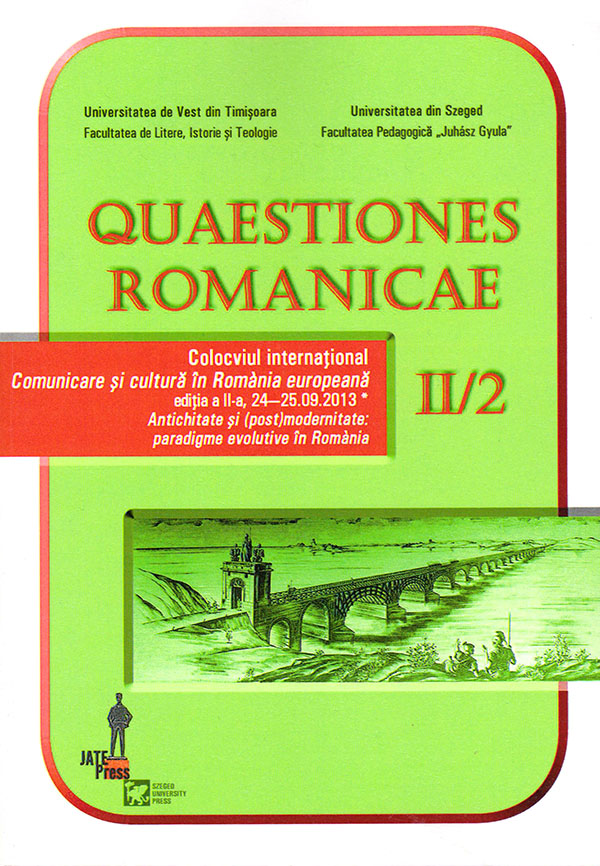Aspecte din istoricul Partidului Naţional-Popular în Banat la finele anului 1946
Abstract: (Aspects from the History of the National Popular Party from Banat at the End of 1946) The National-Popular Party was founded in January 1946 through the transformation of the Patriots'Union, a mass organization initiated and led by the communists. It was conceived, ever since its inception, as a satellite party of the Romanian Communist Party (P.C.R.) to which members of the middle class could adhere, such as intellectuals, traders, industrialists, public and private civil servants, workers and wealthy peasantry. P.C.R. realised that they needed to have this segment of society under its control, which was neither part of the working class nor the peasantry. This party served to some intellectuals as an attempt of salvation from the danger of Sovietisation and Communization of the country. Its foundations, at least at a declarative level, were concepts such as the monarchy, the nation, the church and ownership. Other adherents to the party, former members of the historical parties, including the legionnaires, have tried to shelter themselves under this roof from the potential communist danger, with some of the members building a career within this satellite party of the P.C.R. It attracted personalities of cultural life from Romania and Banat such as: Mitiţă Constantinescu, former governor of the National Bank and a minister during the reign of Carol II; Andrei Oţetea, rector of the University of Iaşi; George Călinescu, director of the significantly-named party paper ,,Naţiunea" (,,The Nation") etc. In Banat, it was joined by cultural personalities such as Pavel Bellu, Petru Sfetca, Alexandru Jebeleanu, Petru Vintilă, Grigore Bugarin etc. It attempted to impose itself in Banat by establishing local organizations in the Timiş-Torontal, Caraş and Severin counties, but it did not have a significant number of members because it entered the political scene relatively late. Consequently, after the November 1946 elections, when it obtained a low score, it was no longer part of the Petru Groza government, in which it had, initially, four ministers and one under-secretary of state. In Banat, the national-populars did not succeed in sending a single member into Parliament following the November 1946 elections. Therefore, its role was a marginal one, even though it had among its ranks, especially in the countryside, a significant number of intellectuals (notaries, priests, teachers etc.). The party tried to overcome its condition by advocating – together with the P.C.R. – the application of the so-called Program-Platform of the National-Democratic Front (F.N.D.), an organization initiated and led by the communists. Therefore, 1946 ended for them with a marginalization from the part of the other parties that formed the F.N.D. and, especially, the P.C.R. that led this organization.
Keywords: the National-Popular Party, Banat, 1946, historian, activity.
Rezumat: Partidul Naţional-Popular a fost întemeiat în ianuarie 1946, prin transformarea Uniunii Patrioţilor, o organizaţie de masă iniţiată şi condusă de către comunişti. El a fost conceput, încă de la început, ca un partid-satelit Partidului Comunist Român, la care să adere aşa-zisele pături mijlocii, adică intelectualii, comercianţii, industriaşii, funcţionarii publici şi particulari, meseriaşii şi ţărănimea înstărită. P.C.R.-ul şi-a dat seama că trebuia să deţină, sub influenţa sa, şi acest segment al societăţii, care nu făcea parte nici din clasa muncitoare, nici din ţărănime. Acest partid a servit unor intelectuali ca o încercare de salvare faţă de pericolul sovietizării şi comunizării ţării, având – ca piloni ai existenţei sale, cel puţin declarativ – Monarhia, Naţiunea, Biserica şi Proprietatea. Alţi aderenţi ai partidului, foşti membri ai partidelor istorice, inclusiv legionari, au încercat să se adăpostească sub această cupolă, în faţa potenţialului pericol comunist, iar unii dintre membri şi-au făcut carieră în cadrul acestui partid, satelit al P.C.R.-ului. El a atras personalităţi ale vieţii culturale din România şi din Banat, ca: Mitiţă Constantinescu, fost guvernator al Băncii Naţionale şi ministru pe timpul lui Carol al II-lea, Andrei Oţetea, rectorul Universităţii din Iaşi, George Călinescu, care era directorul ziarului partidului, numit semnificativ ,,Naţiunea” etc.În Banat au aderat, la el, oameni de cultură ca: Pavel Bellu, Petru Sfetca, Alexandru Jebeleanu, Petru Vintilă, Grigore Bugarin ş.a.El a încercat să se impună în Banat, constituindu-şi organizaţii în judeţele Timiş-Torontal, Caraş şi Severin, dar, venind relativ târziu pe scena politică, a avut puţini aderenţi.În consecinţă, după alegerile din noiembrie 1946, la care a obţinut un rezultat slab, nu a mai făcut parte din guvernul Petru Groza, în care avusese – iniţial – 4 miniştri şi un subsecretar de stat. În Banat, naţional-popularii nu au reuşit să trimită niciun deputat în parlamentul rezultat din alegerile din noiembrie 1946, deci rolul lor, deşi dispuneau – mai ales la sate – de intelectuali (notari, preoţi, învăţători etc.), era marginal.Au încercat să-şi depăşească această condiţie, activând – alături de P.C.R. – pentru punerea în practică a aşa-numitei Platforme-Program a Frontului Naţional-Democrat, organizaţie iniţiată şi condusă de către comunişti. Deci, anul 1946 s-a sfârşit, pentru ei, cu o marginalizare din partea celorlalte partide care formau F.N.D.-ul şi, mai ales, a P.C.R.-ului, care conducea această organizaţie.
Cuvinte cheie: Partidul Naţional-Popular, Banat, 1946, istoric, activitate.
